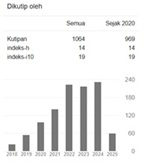ANALISIS KESALAHAN MAHASISWA PGSD DALAM MENYELESAIKAN MASALAH GEOMETRI
Abstract
One of the courses have often difficult by pre service teacher in primary education is Geometry, evidently by learning outcome that are still low. Difficulties experienced by students led to an error occurred in solving problem in geometry. Errors that occur when students solve problems in geometry really need to be known, especially the type of error. One of procedure that can be used to reveal the student error is Newman procedure. This research employed a descriptive qualitative method that aimed to analyze the errors of pre service teacher in primary education when solve the problems in geometry. Participants in this research were two students who have taken the courses of Geometry and meet the criteria which is experiencing a mathematical error. Data collection technique use a question sheet and interviews. Question sheet given in order to analyze student errors that appear. While the interviews were conducted to confirm the results of student work. The results showed that the four stages of the procedure of Newman Error Analyze that comprehension, transformation, process skill and encoding occur mathematical error, logical error and strategic error. Furthermore, as new findings in this research, the error experienced by the students at this stage of the procedure Newman can cause errors in the later stages.
Keywords
Full Text:
PDFReferences
Abu, M. S., & Abdullah, A. H. (2017). Newman Error Analysis on Evaluating and Creating Thinking Skills. December.
Aslan-tutak, F., & Adams, T. L. (2015). A Study of Geometry Content Knowledge of Elementary Preservice Teachers. International Electronic Journal of Elementary Education, 7(510), 301–318.
Avcu, S., & Avcu, R. (2010). Pre-service elementary mathematics teacher’s use of strategies in mathematical problem solving. Procedia - Social and Behavioral Sciences, 9, 1282–1286. https://doi.org/10.1016/j.sbspro.2010.12.321
Browning, C., Edson, A. J., Kimani, P. M., & Aslan-Tutak, F. (2014). Mathematical content knowledge for teaching elementary mathematics: A focus on geometry and measurement. Mathematics Enthusiast.
Haryanti, M. D., Herman, T., & Prabawanto, S. (2019). Analysis of students’ error in solving mathematical word problems in geometry. Journal of Physics: Conference Series, 1157(4). https://doi.org/10.1088/1742-6596/1157/4/042084
Hourigan, M., & Leavy, A. M. (2017). Preservice Primary Teachers’ Geometric Thinking: Is Pre-Tertiary Mathematics Education Building Sufficiently Strong Foundations? Teacher Educator, 52(4), 346–364. https://doi.org/10.1080/08878730.2017.1349226
Huberman, A., & Miles, M. (2012). The Qualitative Researcher’s Companion. In The Qualitative Researcher’s Companion. https://doi.org/10.4135/9781412986274
Imswatama, A., & Muhassanah, N. (2016). Analisis Kesalahan Mahasiswa Dalam Menyelesaikan Soal Geometri Analitik Bidang Materi Garis Dan Lingkaran. Suska Journal of Mathematics Education, 2(1), 1. https://doi.org/10.24014/sjme.v2i1.1368
Jha, S. K. (2012). Mathematics Performance of Primary School Students in Assam ( India ): An Analysis Using Newman Procedure. II(I), 17–21.
Jones, K. (2000). Teacher knowledge and professional development in geometry. Proceedings of the British Society for Research into Learning Mathematics, 20, (3), 109-114.
Marchis, I. (2012). Precervice Primary School Teachers’ Elementary Geometry Knowledge. Acta Didactica Napocensia, 5(2).
Nanna, A. W. I., & Pratiwi, E. (2020). Students ’ Cognitive Barrier in Problem Solving : Picture -based Problem-solving. Al-Jabar: Jurnal Pendidikan Matematika, 11(1), 72–82. https://doi.org/doi.org/10.24042/ajpm.v11i1.5652
National Council of Teachers of Mathematics. (2008). Choice Reviews Online. https://doi.org/10.5860/choice.45-2738
Newman, M. A. (1977). An analysis of sixfll-grade pupils’ errors on written mathematicaI tasks. Research in Mathematics Education in Australia.
Nurhikmayati, I. (2017). Kesulitan siswa berpikir abstrak matematika dalam pembelajaran problem posing berkelompok. 2(2), 159–176.
Özerem, A. (2012). Misconceptions In Geometry And Suggested Solutions For Seventh Grade Students. International Conference on New Horizons in Education, 55, 720–729. https://doi.org/10.1016/j.sbspro.2012.09.557
Ozkan, M., & Bal, A. P. (2017). Analysis of the Misconceptions of 7th Grade Students on Polygons and Specific Quadrilaterals. January, 161–182. https://doi.org/10.14689/ejer.2017.67.10
Peng, A., & Luo, Z. (2009). A Framework for Examining Mathematics Teacher Knowledge as Used in Error Analysis. 3(1997).
Prakitipong, N., & Nakamura, S. (2006). Analysis of mathematics performance of grade five students in Thailand using Newman procedure. Journal of International Cooperation …, 9(1), 111–122. http://home.hiroshima-u.ac.jp/cice/wp-content/uploads/publications/Journal9-1/9-1-9.pdf
Pratiwi, E., Nusantara, T., Susiswo, S., & Muksar, M. (2020). Textual and contextual commognitive conflict students in solving an improper fraction. 8(June), 731–742.
Riastuti, N., Mardiyana, M., & Pramudya, I. (2017). Students’ Errors in Geometry Viewed from Spatial Intelligence. International Conference on Mathematics and Science Education (ICMScE). https://doi.org/10.1088/1742-6596/895/1/012029
Rohmah, M., & Sutiarso, S. (2018). Analysis problem solving in mathematical using theory Newman. Eurasia Journal of Mathematics, Science and Technology Education, 14(2), 671–681. https://doi.org/10.12973/ejmste/80630
Safriani, W., Munzir, S., Duskri, M., & Maulidi, I. (2019). Analysis of Students’ Errors on the Fraction Calculation Operations Problem. Al-Jabar: Jurnal Pendidikan Matematika, 10(02), 307–318.
Salleh, Z., Saad, N. M., Arshad, M. N., Yunus, H., & Zakaria, E. (2013). Analisis jenis kesilapan dalam operasi penambahan dan penolakan pecahan. Jurnal Pendidikan Matematik.
Santos-Trigo, M. (2020). Problem-Solving in Mathematics Education. Lerman S. (Eds) Encyclopedia of Mathematics Education. Springer, Cham.
Santoso, D. A., A, F., & Ulum, B. (2017). Error Analysis Of Students Working About Word Problem Of Linear Program With NEA Procedure. International Conference on Mathematics: Education, Theory and Application.
Sulistyorini, Y. (2018). Error Analysis in Solving Geometry Problem on Pseudo-Thinking’s Students. 160(Incomed 2017), 103–107. https://doi.org/10.2991/incomed-17.2018.22
White, A. L. (2005). Active mathematics in classrooms: Finding out why children make mistakes – and then doing something to help them. Journal of Science and Mathematics Education in Southeast Asia, 15(4), 15–19. http://citeseerx.ist.psu.edu/viewdoc/download?doi=10.1.1.472.9065&rep=rep1&type=pdf
Zilkova, K., Gunčaga, J., & Kopáčová, J. (2015). (mis)conceptions about geometric shapes in pre- service primary teachers. 8(01).
DOI: http://dx.doi.org/10.53712/sigma.v6i1.873
Refbacks
- There are currently no refbacks.
Indexed by:
Published by Prodi Pendidikan Matematika FKIP Universitas Madura
Jl. Raya Panglegur Km 3,5 Pamekasan
Phone: (0324) 322231
website: http://http://ejournal.unira.ac.id/index.php/jurnal_sigma/index
Email: math@unira.ac.id

SIGMA by Universitas Madura is licensed under a Creative Commons Attribution 4.0 International License.

2.jpg)











